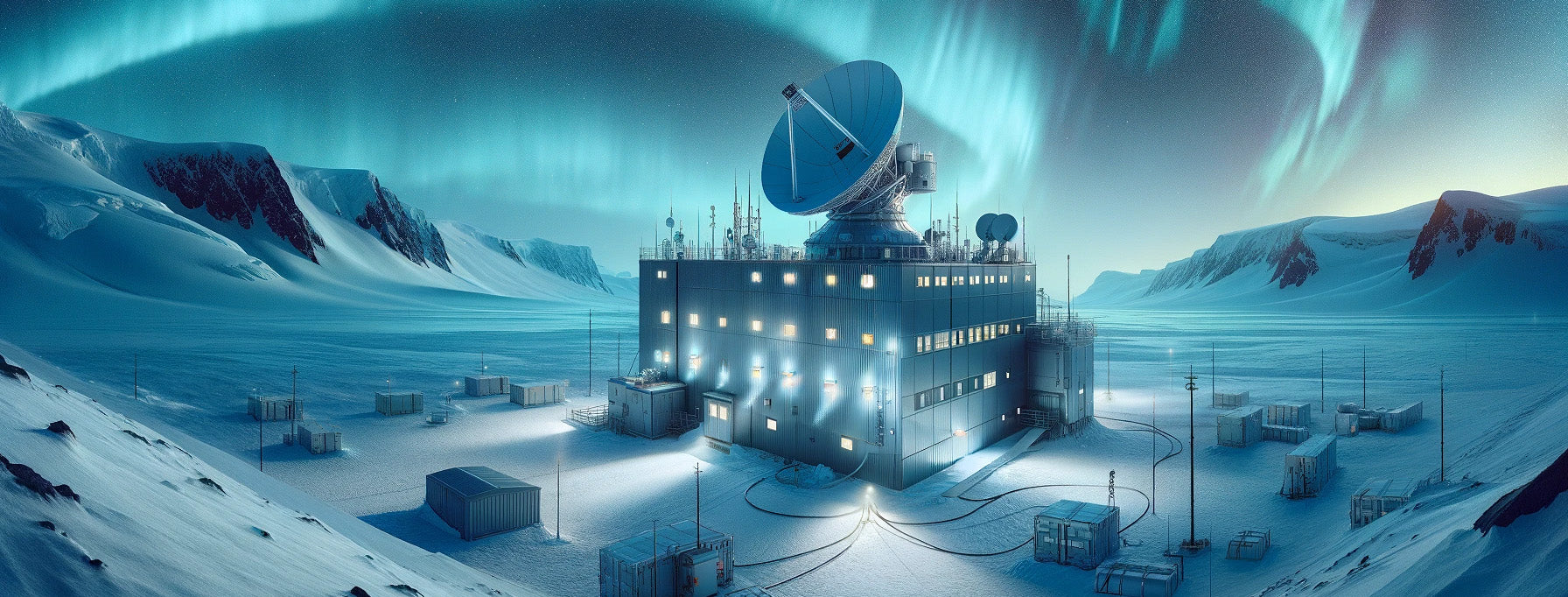
Polar Regions and Your Satellite Network
- 07 Mar, 2024
- Posted by: Michael Mathison
Polar Regions and Your Satellite Network
The polar regions of the planet present unique challenges and opportunities for satellite networks, primarily due to their extreme environmental conditions and the specific orbital dynamics involved. Satellites operating in these areas must contend with the high latitudes' limited geostationary satellite visibility, necessitating the use of polar orbiting satellites to ensure coverage. Additionally, the auroral activity and solar radiation levels in the polar regions can interfere with signal transmission, affecting the reliability and quality of communications.
Despite these challenges, satellite networks play a crucial role in supporting scientific research, climate monitoring, and providing essential communication and navigation services to remote polar communities and vessels operating in these icy waters. The adaptation of satellite technology to function effectively in the polar regions underscores the importance of these networks in connecting and protecting some of Earth's most isolated and environmentally sensitive areas.

Scientific Research
Scientific research in the polar regions significantly impacts satellite networks, both by driving advancements in satellite technology and by presenting unique operational challenges. The extreme conditions and critical importance of polar research for understanding global climate systems and environmental changes necessitate robust and reliable satellite communications and data collection capabilities. Here’s how polar scientific research affects satellite networks:
Explanation:
The demand for data-rich scientific research in the Arctic and Antarctic has pushed satellite networks to evolve, offering enhanced coverage, bandwidth, and resilience in these remote areas. Satellite networks facilitate a broad range of research activities, from climate monitoring and ice sheet studies to tracking polar wildlife and supporting logistics for research stations.
The challenging polar environment, characterized by extreme cold, ice, and periods of continuous daylight or darkness, requires satellites to operate under conditions that differ significantly from more temperate regions. This has led to the development of specialized satellite systems, including polar-orbiting satellites, which can provide global coverage and are particularly well-suited to meeting the needs of polar researchers.
How Scientific Research in the Polar Regions Affects Satellite Networks:
-
Demand for Polar-Orbiting Satellites: Increased need for satellites that orbit close to the poles to ensure continuous coverage and data collection over the polar regions.
-
Enhanced Communication Capabilities: Development of robust communication links to support data transmission and connectivity for remote polar research stations and field operations.
-
Improved Navigation and Tracking: Utilization of satellite networks for precise navigation, tracking of research vessels, and logistics support in ice-covered waters.
-
Climate and Environmental Monitoring: Support for comprehensive climate and environmental monitoring programs, requiring high-resolution satellite imagery and data on polar ice, sea levels, and temperature.
-
Technological Innovations: Drive for technological innovations to improve satellite durability and functionality in extreme cold and solar radiation conditions characteristic of the polar regions.
-
Data Management Challenges: Increased volume of scientific data demands advanced solutions for data management, processing, and storage facilitated by satellite networks.
-
Interoperability and Collaboration: Necessity for interoperability among different satellite systems and international collaboration to share polar research data and maximize the utility of satellite networks.
-
Regulatory and Coordination Efforts: Enhanced regulatory and coordination efforts to manage satellite traffic and minimize interference, crucial for the success of scientific missions in the polar regions.
In summary, scientific research in the polar regions plays a critical role in shaping the development and operation of satellite networks, driving technological advancements and operational strategies to meet the unique demands of these remote and challenging environments.

Expeditions
Expeditions in the polar regions significantly influence satellite networks, as these remote and extreme environments demand robust and reliable communication solutions.
The unique challenges posed by the Arctic and Antarctic have a profound impact on the design, operation, and utilization of satellite networks. Here’s an explanation and a list of how polar expeditions affect satellite networks:
Explanation:
Polar expeditions, whether for scientific research, adventure tourism, or governmental operations, rely heavily on satellite networks for communication, navigation, and safety. The geographic peculiarities of the poles—such as high latitudes, magnetic interference, and the auroral effects—require specific satellite configurations, such as polar orbits, to ensure coverage. Additionally, the severe weather conditions and isolated nature of polar regions necessitate satellite communication systems that can operate reliably under extreme conditions. Consequently, satellite networks must be specially adapted or enhanced to meet these demands, driving innovation and technological advancements in satellite communications.
How Expeditions in the Polar Regions Affect Satellite Networks:
-
Enhanced Coverage Needs: Necessitate satellites in polar orbits to provide continuous coverage and communication capabilities for expeditions across these remote areas.
-
Reliability in Extreme Conditions: Require satellite systems to be highly reliable and resistant to extreme cold, ice buildup, and high levels of solar radiation found in polar regions.
-
High Precision Navigation: Demand for high-precision navigation services to safely guide expeditions through ice-packed waters and treacherous terrain.
-
Real-time Data Transmission: Need for real-time data transmission capabilities for sharing scientific data, emergency communication, and operational coordination.
-
Emergency Response: Enhancement of emergency response mechanisms, including search and rescue operations, facilitated by reliable satellite communication links.
-
Interoperability and Sharing: Promote interoperability among different satellite systems and encourage data sharing agreements to support international scientific collaboration and safety efforts.
-
Spectrum Management: Challenges in spectrum management to ensure reliable communication amidst the unique atmospheric and magnetic conditions of the polar regions.
-
Innovation Drive: Drive innovation in satellite technology, pushing for advancements in power efficiency, data bandwidth, and miniaturization to improve expedition support.
In summary, expeditions in the polar regions play a critical role in shaping the requirements and advancements of satellite networks. The demands of operating in such extreme and isolated environments push for innovation and adaptation in satellite technology, ensuring that these critical networks can provide the necessary support for navigation, communication, and safety for polar explorers and researchers.

Iridium Network
Iridium Communications Inc. operates a satellite constellation providing global voice and data communication, with significant capabilities in the polar regions. Here's an explanation of how Iridium operates in these remote areas, followed by a list of key operational aspects:
Explanation:
Iridium's network is uniquely positioned to serve the polar regions thanks to its constellation of Low Earth Orbit (LEO) satellites. Unlike geostationary satellites, which have limited coverage near the poles, Iridium's satellites orbit approximately 780 km above the Earth, ensuring full global coverage, including the Arctic and Antarctic.
This orbital configuration allows for direct line-of-sight communication between the user's equipment and the satellites, crucial for reliable connectivity in the high latitudes. Iridium's services are vital for expeditions, research stations, and maritime operations in these areas, providing essential communication links for safety, navigation, and scientific data transmission.
How Iridium Operates in the Polar Regions:
-
Global Satellite Constellation: Utilizes a constellation of 66 cross-linked LEO satellites that cover every part of the Earth, including the poles, ensuring continuous coverage.
-
Pole-to-Pole Coverage: Offers seamless, uninterrupted communication services in the Arctic and Antarctic, critical for operations in these remote regions.
-
Low Latency Communication: Because of the low orbit, Iridium provides low-latency communication, beneficial for real-time data transmission and emergency communications.
-
Durability in Extreme Conditions: Iridium devices and services are designed to operate in extreme environmental conditions, including the severe cold and harsh weather typical of polar regions.
-
Support for Scientific Research: Facilitates scientific research by providing data communication services for environmental monitoring, climate studies, and other scientific activities in the polar areas.
-
Safety and Emergency Services: Offers critical safety services, including emergency SOS features and real-time coordination for search and rescue operations.
-
Navigation and Tracking: Supports precise navigation and asset tracking across the polar regions, enhancing the safety and efficiency of expeditions and maritime operations.
-
Interoperability with Other Systems: Iridium's network can integrate with other satellite and terrestrial communication systems, providing a comprehensive solution for polar communication needs.
-
Maritime Communications: Provides communication services for ships operating in polar waters, including icebreakers and vessels engaged in scientific, tourism, and commercial activities.
-
Support for Remote Communities: Delivers essential communication capabilities to remote indigenous communities and outposts in the polar regions.
Iridium's ability to provide reliable communication services in the polar regions significantly impacts expeditions, research, and operations in these remote areas, ensuring safety, facilitating scientific endeavors, and supporting global connectivity.








